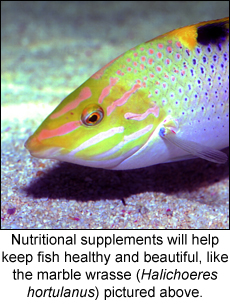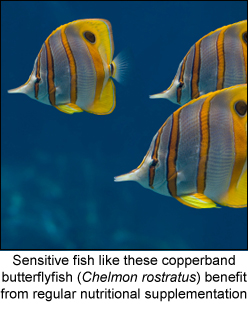Tips From The Pros: Additive Supplements for Fish Foods

Knowing your fish, and what they should be eating, is half the battle of keeping those fish healthy. In fact, for healthy fish, diet is as essential as clean water. For aquarists, that means that feeding the right foods, in the right amounts, is every bit as important as maintaining high water quality. Unfortunately, addressing the individual needs of each fish species an aquarist might own is an article for another day. Instead, todays Tips From The Pros column discusses the use of nutritional additives, and how their effective implementation can cut down on the cost and confusion of feeding your fish the right things.

Sometimes it is just plain difficult to get a handle on the feeding regiment for marine community fish tanks. There are so many dry, frozen, and live food options available on the market today that it can be downright mindboggling to try and find the right choice for every animal. The introduction of so many types of food into the hobby is really a mixed bag. In some ways, all the options are wonderful. They have eliminated the need to purchase fresh market seafood like shrimp and squid. At the same time, many fish stores now dedicate as much shelf space to food stuffs as they do livestock. You can spend all day just trying to select a few options that fill the needs of all your tanks inhabitants.
There are several reasons why it is very important to fulfill the individual nutritional requirements of your fish. Keep in mind that while most fish species begin larval life as carnivores, by the time they grow into juveniles most have switched over to the diet they will maintain until they die. Though some fish are notoriously picky, many others are willing to eat whatever food is available. However, just because a fish finds a food item palatable does not mean that the morsel is nutritionally balanced for that fish. Think about cats and dogs. Dogs are omnivorous; therefore a balanced diet for them should contain a mixture of animal and plant matter. Cats, on the other hand, are true carnivores. Though their kibble may contain corn and other plant-based fillers, cats are designed to eat meat alone. The same principle applies for fish. Some are true carnivores, some are herbivores, and the others split the difference.
Obviously, if you own a mixed selection of carnivores, herbivores, and omnivores, you will need at least two kinds of foodmeat and plants (or algae). Fish eating appropriately balanced diets will exhibit better coloration, more immune resistance towards disease and parasites, better stress tolerance, and more growth. The trick is finding the balance without filling your freezer with a dozen different blister packs of frozen foods. Fortunately, many off the shelf products provide a fairly solid mixture of the carotenoids, amino and fatty acids, and vitamins your fish need. For herbivores, choose foods that are high in the green algae Spirulina, Porphyra, and Palmaria. Carnivores will need foods like krill (Euphasia superba), which is rich in protein, beta-carotene, vitamin A, and essential fatty acids, or cyclops and Apocyclops copepods. Cyclops are usually prepared with up to 12% carbohydrates, a necessary nutrient readily digestible for herbivores, but one which carnivores have more difficulty assimilating directly from algae. Other suitable alternatives include live brine (Artemia spp.) and Mysid (Mysis spp.) shrimp (neither is actually a true shrimp genus), especially since they can be fed with nutritional supplements before they are fed to your fish.
It is important to remember that it is not the need for certain nutrients over others that distinguishes carnivorous fish from herbivores. It is the ratio of these nutrients, and the relative ability to digest and assimilate them, that sets fish apart from one another. It may be that a particular food possesses the right things, but not in the right form or quantity. One of the best ways to ensure that diet provides the best nutrition is to soak the food in a nutritional additive. Products such as Selcon and Nutra Kol NutraPlus come in liquid form, and can be fed directly to live Artemia and Mysids. Freeze dried foods like krill and tubifex worms will also readily soak up nutrient liquids. Good brands of nutritional additives include an assortment of beneficial nourishments, such as Highly Unsaturated Fatty Acids (HUFA) like the Omega-3s, vitamins A, B, and C, and amino acids. Though enriching foods daily is not necessary, nor will it hurt. Doing so a minimum of twice weekly is likely more than enough to significantly boost the nutritional value of your fish food. Equally important is mixing up the dietary offers, as exclusively feeding a single type can also lead to health problems. Krill, for instance, can cause irreversible lockjaw in marine fish when used as the sole food source. However, feeding freeze dried krill soaked in supplement several times a week is a great option to augment other types of feed.

Another nutritional supplement worth mentioning is garlic. Plain old garlicit is renowned for the healthy benefits it confers to humans. It is also used by marine aquarists to treat fish prophylactically, and for parasites. In spite of a lack of scientific corroboration, there is much anecdotal evidence touting the properties of garlic in fish food. Most typically, garlic soaked food is fed to fish exhibiting marine ich (Cryptocaryon irritans). It is also reported to kill internal parasites like nematode worms, allowing the fish to expel them safely. Though not well understood, the benefit is thought to stem from a chemical in the garlic known as Allicin. Garlic is safe enough to use daily and can be used in situ, thereby eliminating the stress caused by removing a sick fish to a quarantine tank. For brevity, I have chosen to omit a garlic treatment schedule for sick fish. However, in a prophylactic capacity, garlic can be added to foods once a week to enhance immune response. There are many liquid and garlic based products now available, but it works equally well to grind up a fresh clove and press out a small amount of oil. The oil can then be mixed with a small amount of RO/DI water and soaking fish food, or applied directly to freeze dried meals. It should be noted that a light slick may occur on the surface of the tank after using garlic oil, and it should be removed by protein skimming. Another option is to feed live brine shrimp with garlic soaked food several hours prior meal time.
As with just about everything in the marine husbandry realm, there are many ways to achieve the same results. In the end, though, I always err toward simplicity. Nutritional supplements are a quick and easy way to ensure that all your fish are getting a balanced diet. They also eliminate the need for all the excess fish foods aquarists tend to collect. Of course, it is all about keeping healthy fish. Healthy fish are clean looking, produce excellent colors, and live a lot longer. For good looking fish, and a great looking tank, you have to give them everything they need.